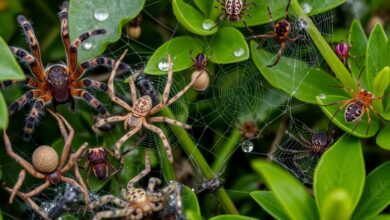Black Widow Spider (Latrodectus): Bite, Symptoms, and Facts
The Black Widow Spider (scientifically known as Latrodectus) is one of the most infamous venomous spiders in the world. Known for its distinct appearance, particularly the female’s shiny black body with the signature red hourglass marking on its abdomen, it has become a symbol of fear and caution.

This spider, often referred to simply as the black widow, is part of the genus Latrodectus, which includes various widow spiders found across the globe.
This article will dive deep into the life of the black widow spider, covering important aspects like the characteristics of their bite, symptoms of envenomation, and other intriguing facts. Understanding this spider is essential for avoiding dangerous encounters and knowing how to respond if bitten.
The Anatomy of a Black Widow Spider

Female Black Widow
The female black widow spider is the most recognized member of the species due to her jet-black body and distinctive red hourglass marking on the underside of her abdomen. She is also larger than her male counterpart, measuring about 1.5 inches (including leg span). Females are known to be more venomous than males, with their venom being highly toxic to humans.
Male Black Widow
In contrast, the male black widow is smaller and less conspicuous. He lacks the red hourglass marking but may have red or white spots on his back. Males are not considered dangerous to humans, as their venom is significantly weaker than that of the female.
Genus Latrodectus
The genus Latrodectus encompasses several widow species, including the southern black widow (Latrodectus mactans), western black widow (Latrodectus hesperus), and northern black widow (Latrodectus variolus). While all species within this genus possess venom, their danger levels can vary depending on the specific species and region.
The Black Widow Spider Bite

Characteristics of the Bite
A black widow bite often occurs when the spider is disturbed, such as when it feels threatened by human contact. Bites typically happen when people accidentally come into contact with the spider’s nest or when it hides in shoes, clothing, or dark corners. The bite itself is usually painless at first but becomes increasingly painful as the venom spreads.

Symptoms of a Widow Bite
While many spider bites cause only mild irritation, a black widow bite can result in serious symptoms due to the spider’s potent venom. Symptoms often begin with pain at the bite site, followed by muscle cramps, abdominal pain, and in some cases, severe neurological symptoms. Other common symptoms include:
- Sweating
- Nausea
- Difficulty breathing
- Elevated blood pressure
If bitten by a black widow, medical attention should be sought immediately, especially if severe symptoms develop.
Treatment and First Aid
Immediate treatment after a black widow bite involves cleaning the wound with soap and water to prevent infection. Applying ice to the bite area can reduce swelling and pain. In cases of severe reactions, antivenom may be administered by healthcare professionals, although this is generally reserved for the most serious cases of envenomation.
Habitat and Webs of Black Widows
Black widows are typically found in dark, sheltered locations such as woodpiles, garages, sheds, and basements. They prefer environments where they can spin their irregular, tangled webs in hidden spots. These webs serve both as a trap for prey and a nest for the spider’s egg sacs.
Web Structure
The web of a black widow is not the classic symmetrical orb shape seen with many other spiders. Instead, it is a chaotic and messy structure, designed to ensnare insects like flies, mosquitoes, and beetles. These webs are extremely strong relative to the spider’s size.
Geographic Distribution
Black widow spiders, particularly the southern black widow (Latrodectus mactans), are native to the United States but can be found in regions across the world. Other species like the western black widow (Latrodectus hesperus) and the northern black widow (Latrodectus variolus) inhabit different parts of North America, adapting to various climates and environments.
Mating and Behavior
Mating Rituals
The mating process of the black widow spider is notorious for the potential risk it poses to the male black widow. In some instances, after mating, the female may consume the male, although this behavior is not as common as popular myths suggest. The primary goal of the female is to produce egg sacs, which she guards fiercely within her web.
Defensive Behavior
Black widows are not aggressive spiders by nature. They tend to avoid humans and will only bite if they feel threatened or are provoked. Their primary defense is retreating to a secluded area within their nest rather than attacking.
The black widow spider is an iconic but potentially dangerous arachnid known for its venomous bite and distinctive appearance. While its reputation often incites fear, understanding the facts about this spider, such as its behavior, venom, and habitat, can help demystify it and promote safer interactions. With proper awareness and caution, the risks associated with black widow bites can be greatly minimized.
If you live in an area populated by Latrodectus species, it is important to take steps to prevent spider infestations and to know how to react if a bite occurs. Although rare, the symptoms of a black widow bite can be severe, and prompt medical attention is key to a full recovery.



